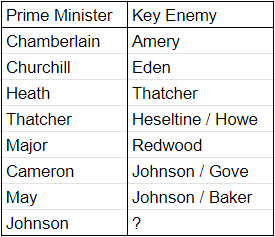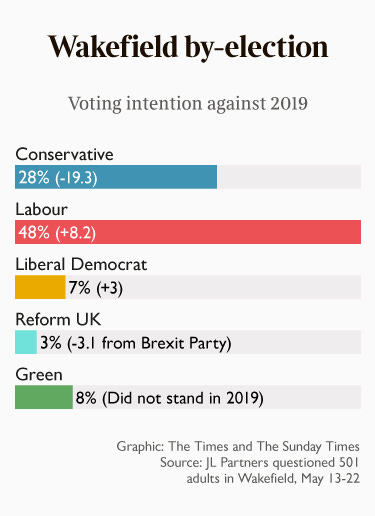State of Play #6: Blue on Blue
The Conservative party civil war is in full flow, but will the rebellion succeed?
Back in the simpler times of 2015 the United Kingdom opted for David Cameron’s conservative party, in the face of what he termed ‘chaos’ under Ed Miliband’s Labour. However, since 2016, Conservative rule has been anything but the ‘strong and stable’ leadership that Cameron, and later May, promised. We are now in the third major Tory civil war in just six years, as the Conservatives continue their 12th year of continuous power in Westminster. But will this reoccurring strain of regicide succeed for a third time?
“One vote is enough”
The words of Jacob Rees-Mogg, proclaiming that even a one vote victory is enough for Johnson’s security in a no-confidence vote; quite remarkable coming from someone who argued that Theresa May should resign after winning almost a 2/3rds majority in 2018.
As The Political Inquiry (TPI) predicted, Johnson won the vote: 211-148 (59%-41%). The margin is superficially comfortable, but in reality, seriously unstable. In comparison, May and Thatcher won their votes by higher or similar margins, but still went on to resign (Two days for Thatcher, six months for May). What is important to understand is that numbers and results in Westminster are anything but binary.
Yes, Johnson remains in power, but the scale of rebellion will make the rest of this parliament (pre-next election) extremely difficult. Johnson’s agenda (if there ever was one) is in tatters, as 75% of backbenchers — and mounting payroll MPs (ministers / PPS) — want him deposed, meaning their reliability to pass legislation or back the government on innovative or tough policy, is greatly reduced.
It’s tragic — more likely symptomatic — that yet another Tory civil war aligns with a period of crisis for the country (2016 Cameron, 2018-9 May). But this time the issues are numerous: a once-in-a-generation economic crisis which requires serious intervention and innovation, the fallout from Brexit in threatening peace in Northern Ireland, the breakup of the United Kingdom with Scottish secession and the eruption of war in Europe once again. This is without mentioning the overhanging danger of the climate emergency.
Don’t expect much ‘tough and innovative’ policy to tackle these issues as bold action is dependent on large majorities, political capital and a leader with authority. Instead, survival is the policy and power the main desire for a conservative party that is so exhausted with constant civil war and 14 years of government, that the best it can muster is a law-breaking political lightweight as leader.
Let a hundred flowers bloom…
A significant worry for Johnson should be the manner in which this no-confidence vote occurred. Of all post-war Tory challenges, rebellion has never naturally occurred from several wings in the party without an ideological position or cabinet minister uniting them.
Hunt’s open vote of no-confidence, as well as Baker, Tugendhat and Harper’s similar positioning, certainly shows desire for leadership. While they all have followings in the Commons (see SOP#3 for a summary of factions), none are cabinet ministers. Therefore, they lack the clout to wield the dagger, namely: the ability to capture headlines and minds, control the media narrative and shift the Westminster atmosphere from Johnson’s sketchy survival to confirmed death — all key elements in forcing the PM’s downfall. With no legislation or ministerial platform enabling them to derail the government (as seen with May and Cameron), they remain tantalisingly close to finishing the PM, but with no tool to complete the job.
However, the number of votes against the PM already stands at 148: just 32 shy of the 180 needed to trigger his resignation. Thus, it’s possible very little has to happen for 180 to eventually reached, whether in a few months or a year. TPI believes that the fate of the PM arguably lies in the hands of his cabinet — especially in the strong leadership candidates like Truss, Wallace, Javid and potentially Gove, Raab or Sunak. An organised rebellion by any of these ministers (likely multiple), could trigger the re-writing of the 1922 committee rules, a second confidence vote, and the subsequent departure of Johnson. If a minister can solidify the narrative of a sinking ship, don’t be surprised if many payroll MPs, and the remaining backbenchers, jump.
It’s testament to Johnson’s absolute desire for power and survival that the majority of his cabinet are so loyal in such dire circumstances. Weaker minsters and ‘yes-men/women’ are great for keeping power, but less so for governing. Most ministers realise they wouldn’t have jobs under any other leader — or their cushy high offices may be downgraded to dingey, lower ministerial positions. Politics is a game of power, so it’s vital to remember many of the cabinet have worked for decade(s) to be at the heart of government. Giving it up, especially when the Tories may only have one more election victory left in their cycle, isn’t a simple choice.
Danger close
So what are the events or circumstances that could finish Johnson? As TPI has been suggesting, the 23rd June (weirdly the same day of the Brexit vote in 2016) is a key hurdle for Johnson. As explained in SOP#5, Johnson faces by-elections in a Labour-Tory red wall marginal of Wakefield, and also in the solid-blue seat of Tiverton and Honiton against the Lib Dems. Wakefield is almost definitely a Tory loss, but the question remains over Tiverton and Honiton — which has a 24,000 Tory majority and is far from a Lib Dem target seat. Yes, the Lib Dem’s are efficient at overturning large Tory majorities — but usually this is on fertile ground: with constituencies containing voters such as the so called ‘Waitrose woman’ (Middle class, graduate, socially liberal but fiscally conservative). This seat, however, is arguably not fertile ground, and not classed as a blue wall target. Thus, for Johnson and the Conservatives, it would be catastrophic to lose the seat.


Catastrophic because electoral victory is power, and one thing any pundit can agree on is the Conservative’s desire for power. The fall of both marginals would solidify the Tory fear of losing the next election to simultaneous attacks in the red wall North (to Labour), and the blue wall South (to Lib Dems) — potentially paving the way for a Lab-Lib coalition government. This Tory electoral nightmare would require split resources, as well as a manifesto catering to intervention (levelling up), as well as restraint (fiscal conservatism) — all during a tricky economic downturn, is potentially impossible. A war on two fronts never ends well, and the Conservatives are right to fear the fight. If both seats switch with emphatic swings, it could be enough to push an all-out rebellion and Johnson’s demise.
However, if Johnson survives Tiverton and Honiton (easily possible) or no real backlash occurs (also possible), then the longer-term trends resume control. Currently, the Bank of England is struggling to ride the thin path of subduing inflation, while not pushing the economy into recession through harsher monetary policy (see Paul Volker for the extreme scenario). The economy is weak, and will seemingly get worse with ONS forecasting a mere 1% GDP growth next year. Continued economic downturn will disable electoral gifts in pre-election budgets, while additionally destroying the ‘classic notion’ of conservative economic competency that has ensured the party’s continued electoral success. Thus, continued scandals, further by-election defeats or eventually the May 2023 elections could cause a drip-by-drip fall of the government.
Although, one element is certain: without an election Johnson’s position is incredibly weak. But, without further electoral defeat his position may not be terminal… yet.








